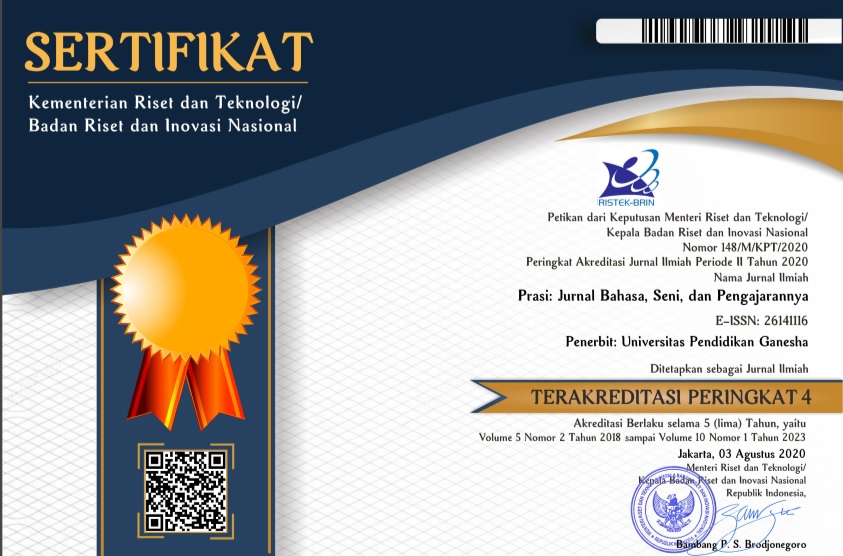THE EFFECT OF SCAFFOLDING TECHNIQUE ON STUDENTS’ WRITING COMPETENCY
DOI:
https://doi.org/10.23887/prasi.v16i01.31152Keywords:
scaffolding technique, writing competency, skillsAbstract
ABSTRACT
Because of Covid 19 pandemic, learning is done in online mode by using various online learning platform. This study aims at investigating the effect of scaffolding technique on students’ writing competency in online learning. To run this research, 60 eleventh grade students of SMAN 1 Sukasada in the academic year 2020/2021 were chosen as the samples. This research applied nonequivalent control group design in which there were two groups compared, namely: scaffolding technique and conventional technique. The data of writing competency were collected by using performance test which were then scored by using analytical scoring rubric. The collected data were then analyzed by using independent sample t test. This research shows that there is no significant effect of Scaffolding technique on students’ writing competency with probability value of 0.606 (p>0,05).
Keywords: Scaffolding technique, writing competency, skills
References
Alibali, M. (2006). Does Visual Scaffolding Facilitate Students’ Mathematics Learning? Evidence from early algebra. http://ies.ed.gov/funding/grantsearch/ details.asp? ID=54
Alt, D. (2016). Students' Perceived Constructivist Learning Environment: Empirical Examples of the Comparison between FACET THEORY with Smallest Space Analysis and Confirmatory Factor Analysis. European Journal of Psychological Assessment. DOI: 10.1027/1015-5759/a000358.
Ashman, A.F and Conway, R.N.F. (1997). An Introduction to Cognitive Education: Theory and Application. London: Routledge
Baradaran, A and Sarfarazi, B. (2011). The Impact of Scaffolding on the Iranian EFL Learners’ English Academic Writing. Australian Journal of Basic and Applied Sciences. 5(12): 2265-2273.
Belias, D., Labros, S., Nikolaos, K., Maria, K and Atanakios, K. (2003). Traditional Teaching Methods vs. Teaching Through The Application of Information and Communication Technologies in the Accounting Field: Quo Vadis? European Scientific Journal. 9(28): 73-101.
Belland, B.R., Glazewski, K and Richardson, J.C. (2007). A Scaffolding Framework to Support the Construction of Evidence-Based Arguments among Middle School Students. Educational Technology Research and Development 56(4). DOI: 10.1007/s11423-007-9074-1
Benson, B. (1997). Scaffolding (Coming to Terms). English Journal. 86(7): 126-127.
Brown, H. D. (2001). Teaching by Principles: An Interactive Approach to Language Pedagogy. White Plains: Addison Wesley Longman.
BSNP. (2012). Laporan BSNP. Jakarta : Depdiknas.
Cakraverty, A. and Gautum K. (2001). Dynamic of Writing. Available at http://exchanges.state.gov/forum/vols38/no3/pp22.htm
Dharma, I.P.S and Adiwijaya, P.A. (2018). The Effect of Problem Based Learning and Self-Assessment on Students’ Writing Competency And Self-Regulated Learning. SHS Web of Conferences 42, 00036. Available at https://doi.org/10.1051/shsconf/20184200036
Elliott, S.N., Kratochwill, T.R., Littlefield Cook, J. & Travers, J. (2000). Educational Psychology: Effective Teaching, Effective Learning (3rd ed.). Boston, MA: McGraw-Hill College.
Ellis, E. S and Larkin, M. J. (1998). “Strategic Instruction for Adolescents with Learning Disabilities”. In B. Y. L. Wong (Ed.), Learning about learning disabilities (2nd ed,585-656). San Diego: Academic Press
Faraj, A.K.A. (2015). Scaffolding EFL Students’ Writing through the Writing Process Approach. Journal of Education and Practice. 6(13): 131-141
Harmer, J. (2006). The Practice of English Language Teaching. Cambridge: Pearson Longman
Hasan, M. (2018). Impactof Motivational Scaffolding on the Acquisition of Writing Skillsin L2 Situation. International Journal of Humanities and Social Science Invention (IJHSSI). 7(12): 39-45
Hogan, K., & Pressley, M. (Eds.). (1997). Scaffolding Student Learning: Instructional Approaches and Issues. Cambridge, MA: Brookline.
Kamberi, L. (2013). The Significance of Teacher Feedback in EFL Writing for Tertiary Level Foreign Language Learners. Procedia-Social and Behavioral Sciences. DOI: 10.1016/j.sbspro.2013.01.241
Larkin, M. (2002). Using Scaffolded Instruction to Optimize Learning. Arlington, VA: ERIC Clearinghouse on Disabilities and Gifted Education. (Retrieved July 25, 2020 from ERIC at EBSCOhost, ERIC No. ED. 474 301).
Lipscomb, L., Swanson,J and West, A. (2010). “Scaffolding” In M. Orey (Ed) Emerging Perspectives on Learning, Teaching, and Technology. Available: http://projects.coe.uga.edu/epltt
Lund, A. & Hauge, T. E. (2011). ‘Changing Objects in Knowledge-Creation Practices’ in S. Ludvigsen, A. Lund, I. Rasmussen & R. Säljö (eds.) Learning Across Sites: New tools, Infrastructures and Practices. London: Routledge, 206-221.
Majid,A.H., Stapa,S.H and Keong, Y.C. (2015). Blended Scaffolding Strategies Through Facebookfor Learning and Improving the Writing Process and Writing Performance. International Conference on Social Sciences & Humanities (ICOSH-UKM2012)
Marhaeni, A.A.I.N. (2005). Pengaruh Assessment Portfolio dan Motivasi Berprestasi dalam Belajar Bahasa Inggris terhadap Kemampuan Menulis dalam Bahasa Inggris. Unpublished Dessertation: Proram Pascasarjana Universitas Negeri Jakarta
McCarthy, J.P and Anderson, L. (2000). Active Learning Techniques Versus Traditional Teaching Styles: Two Experiments From History And Political Science. Innovative Higher Education. 24(4): 279-294
Meyers, A. (2003). Composing with Confidence: Writing Effective Paragraphs Essays. New York:Addison Wesley Longman Inc.
Northern Illinois University. (2019). Instructional Scaffolding to Improve Learning. Spectrum. Available at www.facdev.niu.edu
Nyikos, M and Hashimoto, R. (2011). Constructivist Theory Applied to Collaborative Learning in Teacher Education: In Search of ZPD. The Modern Language Journal. 81(4): 506-517. Available at https://doi.org/10.1111/j.1540-4781.1997.tb05518.x
Oktavianus, H. (2016). The Use of Scaffolding Technique to Teach Recount Text Writing. Journal of Research Universitas Tanjung Pura.
Sari, D.S., Suparman, U and Sinaga, T. (2018). The Effectiveness of Scaffolding Technique on Students' Writing Analytical Expository Text. Publised Research by University of Lampung
Urquhart, V and McIver, M. (2005). Teaching Writing in the Content Areas. Virginia: ASCD
Veerappan, V A/L., Suan, W.H and Sulaiman, T. (2011). The Effect of Scaffolding Technique in Journal Writing among the Second Language Learners. Journal of Language Teaching and Research. 2(4): 934-940
Vonna, Y., Mukminatien, N., and Laksmi, E. (2015). The Effect of Scaffolding Techniques on Students’ Writing Achievement. Jurnal Pendidikan Humaniora. 3(1): 227-233
Vygotsky, Lev. (1978). Mind in Society. London: Harvard University Press.
Zarandi, S.Z. A and Rahbar, B. (2014). Enhancing Speaking Ability through Intervening Scaffolding Strategies. Theory and Practice in Language Studies. 6(11): 2191-2195. Available at http://dx.doi.org/10.17507/tpls.0611.17
Zhao, R. And Orey, M. (1999). The Scaffolding Process: Concepts, Features, and Empirical Studies. Unpublished manuscript. University of Georgia.
Downloads
Published
Issue
Section
License
Authors who publish with Prasi agree to the following terms:- Authors retain copyright and grant the journal the right of first publication with the work simultaneously licensed under a Creative Commons Attribution License (CC BY-SA 4.0) that allows others to share the work with an acknowledgment of the work's authorship and initial publication in this journal
- Authors are able to enter into separate, additional contractual arrangements for the non-exclusive distribution of the journal's published version of the work (e.g., post it to an institutional repository or publish it in a book), with an acknowledgment of its initial publication in this journal.
- Authors are permitted and encouraged to post their work online (e.g., in institutional repositories or on their website) prior to and during the submission process, as it can lead to productive exchanges, as well as earlier and greater citation of published work. (See The Effect of Open Access)


.png)
.png)









